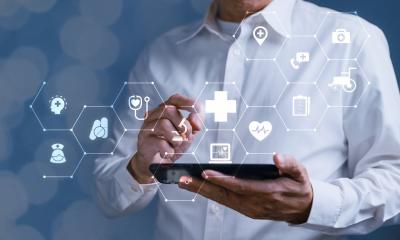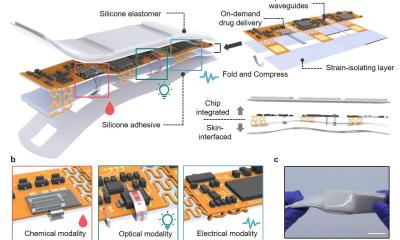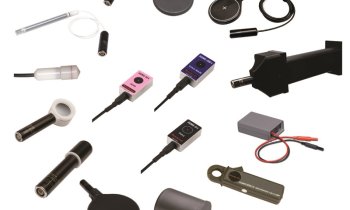Image source: Shutterstock/ra2 studio
Article • Remote patient monitoring
Wearables must demonstrate efficacy in respiratory care
Wearables are becoming a trend in respiratory care and many products are being developed to monitor patients remotely. But how much can these tools really help clinicians? An Italian expert presented currently available solutions and the challenges to their development during the presidential summit of the European Respiratory Society (ERS) in June.
Report: Mélisande Rouger

Whether they use rigid or soft technology, wearable devices have drastically expanded remote patient monitoring capabilities to the entire population, according to Andrea Aliverti, a professor of bioengineering who teaches Sensors and Instrumentation Technologies and Bioengineering of the Respiratory System at the Polytechnic University in Milan, Italy. “Consumer-grade wearable sensors are changing the model of patient assistance and monitoring,” he said in the session that was held online.
Certification remains an issue
Many systems are being developed that can help monitor respiratory functions remotely. The point for clinicians is to understand which tools can be considered biomedical sensors, especially now that the new regulation on medical devices is fully applied in the EU. “This will be the basis for products to make the transition from gadgets that are used for personal use into medical devices, with specific pre and post market requirements and the certification released after proper evaluation,” he said.
A few wearable solutions have received the FDA certification and can help evaluate cardiac and respiratory functions. For example, tools using photo-plethysmongraphy (PPG) allow to measure heart rate, heart rate reserve (HRR) and cardiac output stroke volume with high accuracy. “These solutions also offer the possibility to collect information about oxygen saturation and pulse-based parameters in the finger and the wrist,” Aliverti said. For arrythmia detection, systems that integrate a medical grade electrocardiogram (ECG) with a smart watch have also received the FDA certification. Pulse oximetrimeters that enable to position optical systems can help evaluate oxygen saturation close to the wrist, with different levels of accuracy. “Interesting solutions that don’t interfere much with daily life activities are coming out,” he said. “But these systems are only partly certified.”
Recommended article

Article • Cardiac care to go
Wearables in cardiology: from activity monitoring to research support
Activity monitors via phones and bracelets help to assess exercise but experts question which device may really stimulate activity in cardiovascular patients, and which might be best for research?
Regarding physical activity and actigraphy, a basic accelerometer allows to measure step count, speed and time. Barometers and GPS systems can help detect and estimate the level of patient activity.
Measuring different parameters
We need to develop solutions that provide medical grade measurements, are certified as medical devices and provide the highest safety to protect patient privacy
Andrea Aliverti
A more daunting task is to measure respiratory parameters, such as tidal volume, which is measured at each breath during inspiration or expiration. “This is not completely solved, but there are solutions out there,” said Aliverti, who presented a system he recently developed with other researchers around the world. The solution uses continuous and real-time breathing pattern monitoring boosted (recognized) by artificial intelligence to measure tidal volume and respiratory rate with different levels of activity during the day. “It’s important to combine multiple measurements to obtain parameters that are related to the level of activity and the posture that the patient assumes,” he said.
Another multimodal system Aliverti has helped create is a home telemedicine tool for continuous respiratory monitoring, integrating different sensors not only on the body but also in the environment, for instance sensors for air quality. “The solution shows the variability of the respiratory rate with respect to the changes in the environment parameters,” he said.
In Covid-19, several papers have showed that combining different measurements taken with wearables allows to identify early by four or five days before the onset of symptoms. In COPD, promising preliminary data is available, but better designed clinical trials are necessary to show how wearables can identify signs of exacerbation. Measuring the respiratory rate by placing sensors on the skin could also help detect neuromuscular disorders. “It’s an indication, but it’s often forgotten.”
Another important area is sleep monitoring technology, with promising solutions that can collect ECG, respiratory rate and other measurements in garments during daily activities and sleep. “These devices open new perspectives in monitoring sleep with a very low level of intrusiveness, he said. Wearables will allow to transition from very cumbersome systems to new less obstructive solutions.” Evaluating these tools’ efficiency will be key in the future. “We need to develop solutions that provide medical grade measurements, are certified as medical devices and provide the highest safety to protect patient privacy,” he concluded.
The session also featured a talk on the lessons learned with Covid-19 contact tracing by Vitalii Poberezhets from the National Pirogov Memorial Medical University in Vinnytsia, Ukraine. Kijeld Hansen, chair of the European Lung Foundation, focused on the patient’s perspective and Ioannis Viogatzis, a professor of rehabilitation sciences at North Umbria University in Newcastle, UK showed how wearable technology can be used in sports and elite athletes.
Profile:
Andrea Aliverti (MSc in Electronic Engineering, 1992, PhD in Bioengineering, 1997) is Full Professor at the Department of Electronics, Information and Bioengineering (DEIB) at the Politecnico di Milano where he teaches Sensors and Instrumentation Technologies and Bioengineering of the Respiratory System. He also teaches Biomedical Electronics and Instrumentation at the Medtec Course in Medicine and Biomedical Engineering (Politecnico di Milano-Humanitas University).
03.12.2021











